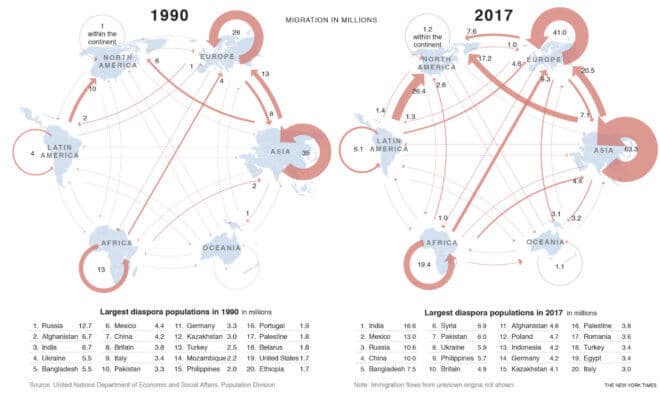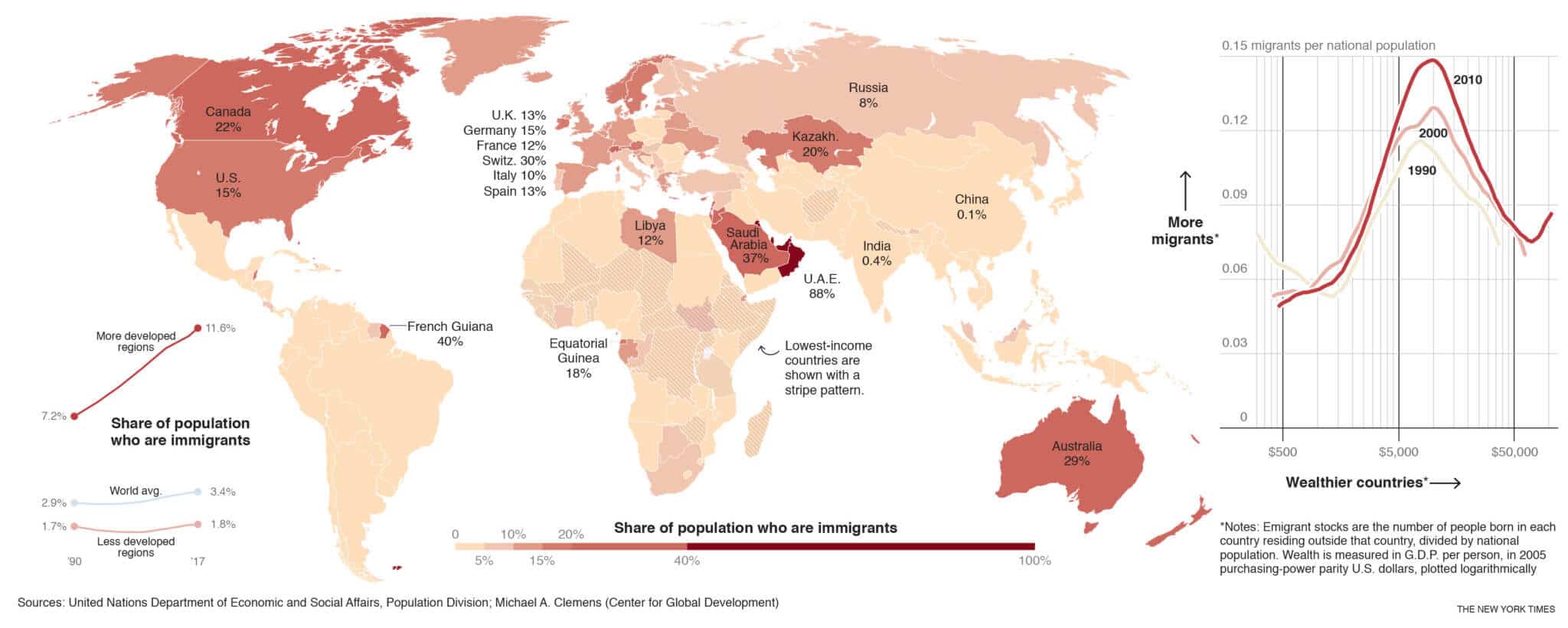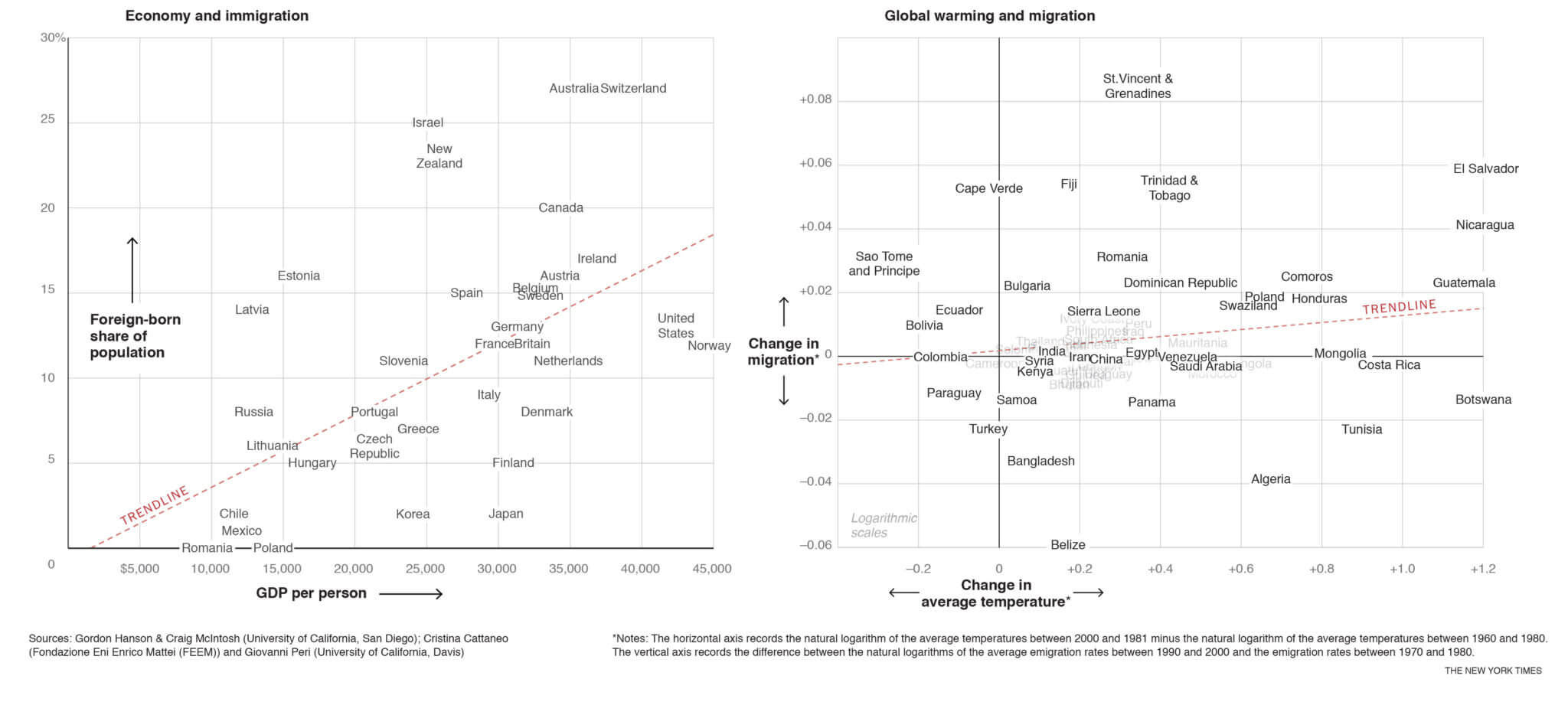Immigration
Immigration Myths and Global Realities

All over the world, migration has grown sharply over the last quarter-century.
Immigration is reshaping societies around the globe. Barriers erected by wealthier nations have been unable to keep out those from the global South — typically poor, and often desperate — who come searching for work and a better life. While immigrants have often delivered economic benefits to the countries taking them in, they have also shaken the prevailing order and upended the politics of the industrialized world — where the native-born often exaggerate both their numbers and their needs.
Donald Trump’s promise to build a wall to keep Mexicans and Central Americans from crossing the United States’ southern border was central to his successful campaign for the presidency. Antipathy toward immigrants is spreading through Europe, fueling Britons’ desire to leave the European Union, upending Italy’s political establishment and giving the populist Hungarian government of Viktor Orban a fourth term.
Fear of immigrants takes different forms. Immigration from the Middle East and North Africa has led to calls in Europe to prevent its so-called Islamization. In the United States, despite a long history of cultural, religious and ethnic mixing, several studies have concluded that alongside their anger over lost jobs and stagnant wages, many of the non-Hispanic white voters who tipped the presidency to Trump were motivated by fears that they were losing demographic ground to other groups.
While it is far from a consensus, on both sides of the Atlantic the proposition that immigration amounts to a large-scale threat is gaining ground on the right of the political spectrum.

— People perceive there are more immigrants than there really are
A study based on surveys in the United States and a variety of European countries by economists Alberto Alesina, Armando Miano and Stefanie Stantcheva found that people across the board vastly overstate their immigrant populations.
The overestimates are largest among particular groups: the least educated, workers in low-skill occupations with lots of immigrants, and those on the political right. They overstate the share of immigrants who are Muslim and understate the share of Christians. They underestimate immigrants’ education and overestimate both their poverty rate and their dependence on welfare. Almost a quarter of French respondents, as well as nearly 1 in 5 Swedes and about 1 in 7 Americans, think the average immigrant gets twice as much government aid as native residents do. In no country is this true.
“People who are are against immigration generate a sense of crisis,” Alesina said. “They create a sense that ‘This is a huge problem; we need a wall.’”
In any event, the sentiment is eroding support for Europe’s social democratic model as well as for the United States’ more limited social safety net. “Just making people think about immigrants generates a strongly negative reaction in terms of redistribution,” Alesina, Miano and Stantcheva write. This raises a fundamental question. If immigration from the South continues apace, will support for the liberal market democracies with robust social safety nets, which have prevailed in northern countries since the middle of the 20th century, hold in the 21st?
— The flow of migration varies around the world
Immigration is unlikely to slow down. All over the world, migration has grown sharply over the last quarter-century. In 1990, fewer than 7 million Indians lived abroad, according to calculations from the United Nations. By last year, nearly 17 million lived outside of India. The Mexican diaspora increased to 13 million from 4.4 million over the period. China’s rose to 10 million from 4.2 million.
Most migrants from poor countries never make it to the United States or Western Europe, instead moving to other developing countries nearby. A little over half of emigrants from Africa settle in other African countries, while 60 percent of Asian migrants relocate elsewhere in Asia.
— Immigrant populations have risen sharply in most advanced nations
The economic pressures pushing migrants from their homes is unlikely to abate soon. But the patterns of migration from the poor South of people seeking a better life in the rich North is likely to change.
— Economic and other forces are driving immigration
While instability in Central America continues to drive people north, the vast traffic of low-skilled immigrants into the United States across the southern border has slowed. The demographic bulge of Mexican men in their teens and early 20s who flocked illegally to the United States from the 1990s until the Great Recession has petered out, in part a consequence of declining Mexican fertility since the 1970s. Today, Mexicans are older, on average. Fewer are willing to take the risk. And Mexico’s economy is in better shape than in the 1980s and 1990s, when repeated crises drove many Mexicans from their homes.

There were fewer unauthorized immigrants living in the United States in 2016 than in 2007. Apprehensions along the border with Mexico plummeted last year to their lowest level since 1971. Things may change if, say, Trump decides to leave the North American Free Trade Agreement, setting off another economic crisis in Mexico. Still, the United States seems more likely to suffer from a lack of immigrants than from a continued surge.
Although immigration into the United States might have passed its high-water mark, other parts of the rich world — Europe, notably — are likely to experience more immigration than they have before.
Consider Africa. As Gordon Hanson and Craig McIntosh of the University of California, San Diego, have noted, immigration across the Mediterranean may soon come to look like the vast flows of people who in the 1990s streamed across the Rio Grande.
The number of migrants from sub-Saharan Africa jumped 25 percent over the first decade of this century and surged 31 percent from 2010 to 2017, according to the Pew Research Center. Persistently high fertility rates across Africa have produced a demographic bulge of young people eager to make a better life across the Mediterranean.
Demand for immigrant labor will probably rise in Europe as its population ages. The number of working-age people is already shrinking in many countries. What’s more, migration from many poor African countries is likely to keep rising even as their economies develop: They will remain poor enough for many of their people to crave a better life elsewhere but will become rich enough for more of them to afford the journey.
— Migration peaks in lower-income countries
Research by Michael Clemens of the Center for Global Development finds that incomes per capita in the countries with the largest diaspora populations range roughly from $7,000 to $20,000. Some big African countries — like Nigeria — have entered that range.
Then there is the wild card, which could well intensify patterns of migration everywhere: climate change.
— Global warming is driving migration
Rising average temperatures are already pushing people from their homes in many middle-income countries, according to research by Cristina Cattaneo and Giovanni Peri, increasing migration from rural areas to urban centers and across borders to other nations. As warming continues in the coming decades, it will probably push people from agricultural areas to urban areas and from the global South to the richer global North.
How will the North’s political systems respond to the challenge? Alongside studies suggesting that ethnic diversity can reduce trust and support for social insurance, there is a body of scholarship suggesting that direct contact between people of different ethnicities, nationalities and cultures can breed trust: It’s easier to fear an abstract immigrant you have never seen than one who lives down the block, sends children to the same school as yours and shops at the same store.
The research by Stantcheva, Miano and Alesina suggests that Americans who know an immigrant have more positive perceptions about immigrants’ work ethic, education, dependence on welfare and other behavior. Across the countries in their study, people exposed to positive images of immigrants — say, about their strong commitment to work — become much less negative in general about immigration.
Natives’ views can also be manipulated in a negative direction, though, something currently reflected in the politics of many countries. Stantcheva argues that negative portrayals of immigrants in the media could help explain the biased and erroneous views about immigrants’ behavior. And as Alesina notes, “Anti-immigration parties foster these misperceptions in a variety of ways strategically to gain support for their anti-immigration stands.”
But there are already plenty of walls, and they have done little to stop immigration. If rich countries want fewer immigrants, their best shot might be to help poor countries become rich, so that fewer people feel the urge to leave. That would include helping them adapt to climate change, and simply opening up their own markets to developing countries’ exports. “If you want to have fewer immigrants, you would want poorer countries to take advantage of trade,” Alesina said. “The idea that because there is too much immigration you should restrict trade makes no sense.”
What’s more, as Clemens argues, rich countries should probably start writing new rules and creating new institutions to manage the large immigration flows of the future. They could work to promote new destinations and develop mutually beneficial forms of migration (say, varieties of temporary work visas). They could establish mechanisms to assist vulnerable native-born people, whose jobs might be at stake.
If properly handled, Clemens says, immigration is an opportunity.
@2018 New York Times News Service
